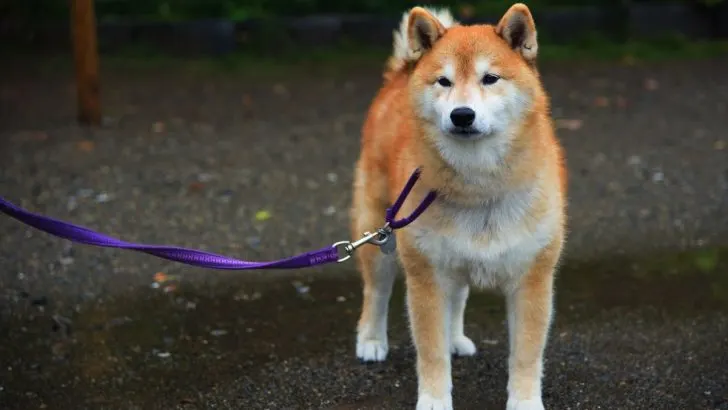The Japanese Akita is a well-known hunting and guard dog breed originating from the mountains of northern Japan.
Today, we will analyze all the possible Akita Colors and the genetics that make them.
These large dogs are known for their massive strength, undying loyalty, and imposing presence.
These dogs have a dense and plush double coat, coming in various colors from red to brindle to snow white.
Non-standard And Standard Akita Inu Colors
Every dog breed has a specific standard that describes all the traits the breed should have. Those traits include things like temperament and size, but the coat color and texture of the ideal breed representative as well.
The major kennel clubs usually follow the affiliated breed club standards. The standards are often similar in the general outline, but details like coat color and such can differ.
| AKC | FCI | KC | |
|---|---|---|---|
| RED | accepted | accepted | accepted |
| SESAME | not accepted | accepted | accepted |
| BRINDLE | accepted | accepted | accepted |
| WHITE | accepted | accepted | accepted |
Now, for the fun part, let’s take a closer look at the Akita color combinations and patterns and see where they stand with the major kennel clubs.
1. The Red Akita Inu

One of the most well-known Japanese Akita Inu coat colors is red (or aka as it is known in Japanese).
Suppose we dig deeper into the genetics of a red Akita Inu. In that case, we can notice these dogs express a clear sable pattern with a rich and vivid red phaeomelanin intensity.
Akita Inu dogs that have a red fawn coat can never have any black shading
In contrast, red Akita Inu has to have countershading; in Japanese dog breeds, it is called urajiro.
Urajiro refers to cream or white Akita markings on the underside of the dog and the lower body.
Countershading immensely lightens the phaeomelanin on the chin of the dog, as well as the throat, the chest of the dog, the belly and the underside of the tail with lower legs included.
On Aktia dogs with a red fawn coat, the lighter regions fade more or less slowly into the red areas.
All red Japanese Akita dogs should have a white tip on their well-curled tail.
We can’t mention the Japanese term urajiro (translating to underside white) without mentioning the term omotejiro that breeders use.
Omotejiro means front white in Japanese, and it is used to describe white or cream countershading that is usually found on the sides of the muzzle and the cheeks of the dog. Yet, both of these traits go hand in hand.
We can even notice some red fawn Akita pups that seem to have some extent of white markings from Piebald.
Ultimately, some residual white or minimal white spotting on a red Akita Inu often goes unnoticed because it covers the same areas as the urajiro pattern, which already has white coloring,
Just a few red dogs show apparent signs of the piebald pattern, like a white collar, a big white chest patch, solid white legs, or a white blaze that reaches past the ears (‘hachiware‘).
Some dogs have large white areas. However, a pinto pattern or any excessive white on the body or the head of the dog is evaluated as a mismark and is undesirable.
2. The Sesame Colored Akita Inu
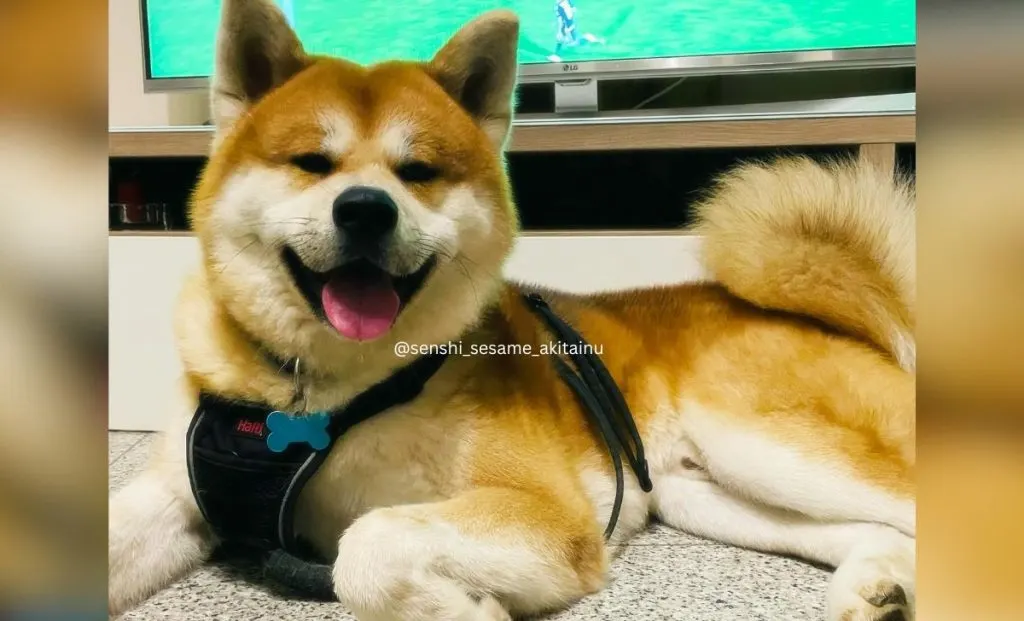
The American Kennel Club (AKC) does not list sable shading as a recognized color.
However, the Fédération Cynologique Internationale (FCI) and the British Kennel Club (KC) describe the sesame color as red fawn hairs with black tips.
When looking at this from a genetic standpoint, this refers to shaded sable dogs or even to agouti patterned dogs in some relatively rare instances.
We can notice some red Akita pups showing minor puppy shading, but that fades as they age.
However, the Akita Inu color we call sesame, or goma as the Japanese call it, no longer exists within the Akita Inu breed.
Even the Japan Dog Preservation Society does not contain sesame in its list of likely coat colors.
3. The Brindle Patterned Akita Inu
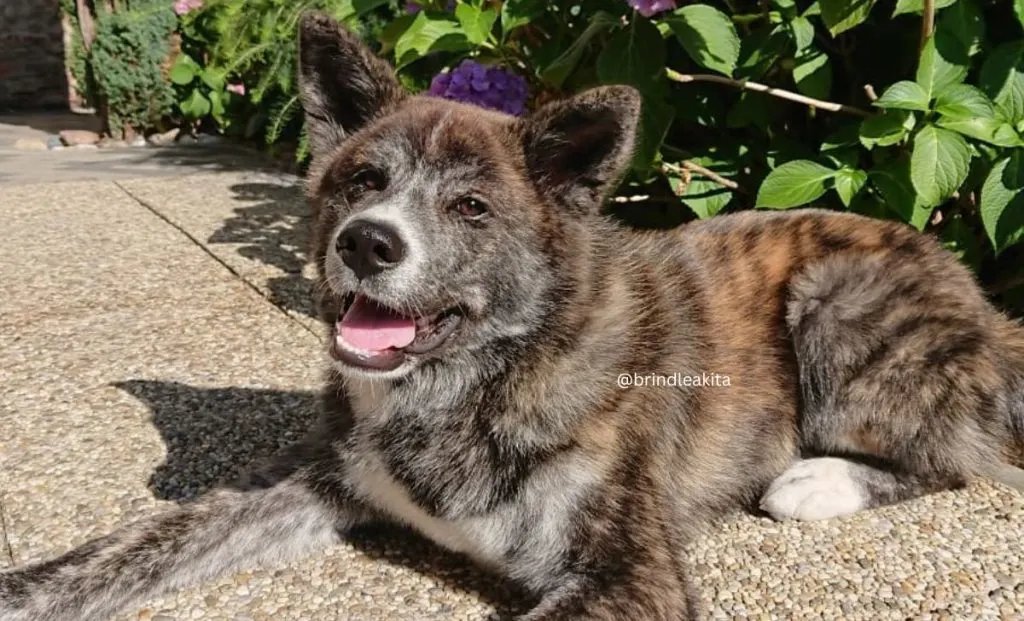
When talking about a brindle coat, it must have clearly defined black lines or stripes laid over a light base color.
From a genetic standpoint, this coat is red sable with brindle stripes. The brindle pattern must be uniform, without any gaps.
Like the red Akitas, all brindle Japanese Akita Inu dogs exhibit urajiro but only in the red parts of the coat.
Since we have the black stripe pattern on top, it covers most of the countershading. As the urajiro shading mixes slowly into the sable coat base color, it is almost invisible on brindle Akita pups.
The light pigment combined with black eumelanin from the brindle pattern often looks greyish. An Akita Inu with a red base color and silver brindle can look gorgeous!
Akita Inu dogs with a brindle pattern can come with dense to moderate lining and have any base shade between red and silver-white. Akita breed enthusiasts distinguish between an assortment of patterns:
- Japanese Akita Inu brindle (translated to tora in Japanese) is called kurotora (meaning black brindle) in dogs with a large number of black colors in their striping patterns
- akatora (meaning red brindle) on a noticeable red base color of differing shades
- shimofuri (meaning silver brindle) on a cream to silver-greyish sable base coat color
If the gray pieces on a silver brindle Japanese Akita dog have a very low intensity, they are sometimes called shirotora (meaning white brindle). But even a silver brindle Akita Inu frequently has some red or yellow shading.
Brindle Japanese Akita usually comes with negligible white spotting, which can cover some of the dog’s brindle pattern.
The preferred pattern has roppaku (meaning six white markings) on the dog’s muzzle, the tip of the tail, and each of the four paws. If the white spotting extends further, some Akitas can have something we call a blaze.
But just as in red Akita dogs, a white collar or a tuxedo blazer that splits the head pattern in the middle (called hachiware) is considered a mismark with the major kennel organizations.
4. The White Akita Inu
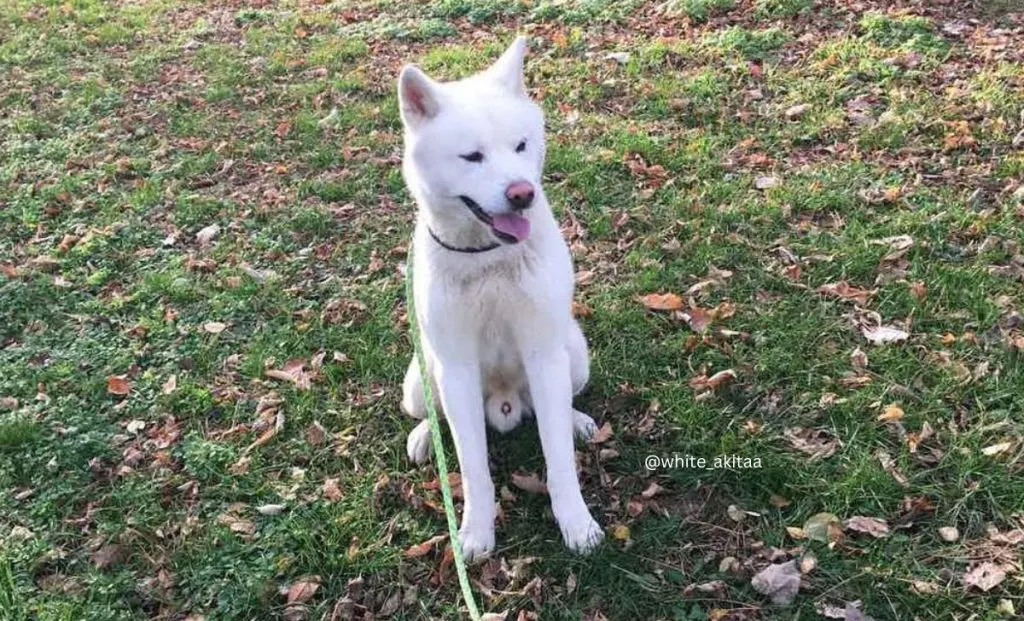
When an Akita dog is entirely white or shiro, it is caused by the recessive red with low phaeomelanin intensity.
According to the Amerikan Kennel Club (AKC) breed standard, Akita Inu, which is white, must be as bright a white shade as possible.
While it is considered a fault by the breed standard, many shiro Japanese Akita dogs have different coloring or even red shades on their ears, shoulders, or tails.
Although frequently not visible, even an Akita that is all white can have piebald spotting.
The catch is that these non-pigmented regions are only observable in shiro Akitas, which have some grade of red-colored shading where the Piebald pattern can cover up some red color.
Pure white Akita nonetheless have black eumelanin and can’t grow black hairs in their coat.
However, the lips, skin pigment, eye rims, or nose are still black-pigmented. Nonetheless, it is pretty standard in all-white Akita dogs to have fading nose pigment.
A Deep Dive Into Akita Inu Genetics
Every dog gets its colors from two pigment types named eumelanin and phaeomelanin.
Various proportions of colors in a particular dog’s coat create multiple patterns.
The Akita, just like most dog breeds, can only make some of all possible colors.
Eumelanin Colors
All the Akitas are fixed for black eumelanin. Even if not present in red or white coats, eumelanin gives color to the nose, skin, nails, or eyes.
Phaeomelanin Intensity
The phaeomelanin intensity in Japanese Akita ranges from a vivid red on red fawns to a light cream or white on white dogs.
On the other hand, Brindle Akita dogs can also have a kind of yellowish or silver base shade. Some pale or blonde Akitas exist, but they are deemed undesirable.
Body regions with urajiro markings fade to a low-intensity color between light cream and white.
White Spotting
Japanese Akita comes with urajiro, which causes a light cream coat on the dog’s face and underside.
However, countershading is not precisely the same as white spotting! But the piebald gene seems to be present in this breed.
Something else seems to control the actual amount of white in piebald patterns. In Akitas, breeders have been selecting for minor to moderate white patterns.
White spotting in Akita dogs can form a pseudo-Irish pattern resembling the proportional spread of white color on the muzzle and blaze of the dog, the tail tip, the underside, and the lower legs found in many herding breeds.
A miniature blaze and a little white are accepted or encouraged in the matter of the six white roppaku spots on the paws, muzzle, and tail tip in brindle dogs.
Yet a white mask, any extended white coloring on the legs or chest of the dog, any pinto patterns on the coat, a full white collar around the neck of the Akita or even a tuxedo blaze expanding from the muzzle of the dog to the back of the neck (hachiware) are mismarks with the breed standard.
It is not constantly possible to see white markings on an urajiro pattern.
Even white Akitas can have white spotting; seeing non-pigmented regions on a dog with almost white-pigmented fur is harder!
Akitas And Patterns
The official patterns in a dog breed standard characterize the distribution of colors in the dog’s coat. Canines can be solid-colored or have a pattern with additional colors.
Breed standards nearly constantly use breed-specific and purely descriptive terms.
We sometimes need to translate breed standard terminology into more universal genetic terms. And that can be pretty tricky.
Sometimes, the same term is used for colors caused by different genes. In other cases, however, genetically similar phenotypes have many different names.
Eye and Nose Colors in Japanese Akita
All Japanese Akita dogs are fixed for black eumelanin pigment.
So, no matter if a Japanese Akitas is red or brindle, it must have a black nose, dark brown eyes, and black pigment on its lips, eye edges, paw pads, or nails.
But the tongue of this dog breed shouldn’t be black or spotted.
Regardless, white Akita dogs are recessive reds. They frequently have nose pigment fading to pink, which is ordinary for this pattern.
According to the significant kennel clubs, a flesh-colored snow nose is acceptable with white dogs.
Some pups are born with a somewhat pigmented butterfly nose that occasionally stays in adulthood (in Japanese, it is called ‘hanakake‘). It’s considered a fault by the breed standard.
Akita Inu Coat Types
The Akita is a spitz-type dog breed with a double coat (translated to Japanese, nijuuhimou), delivering insulation in cold environments.
The hairs on the dog’s rump, withers, and tail can be a bit longer than on the remainder of the body.
Genetically looking, the Akita is a smooth-coated dog breed, and it shouldn’t have a ruff or any feathering.
The American Kennel Club breed standard describes three types of hair:
- Long guard hair that stands out like needles from the body of the dog
- Coarse guard hair that has to lie flat on the body
- The soft, wooly undercoat, which can be a different color than the outer coat
Other Coat Types in Akita Inu
Some Akita express long coats, creating a non-standard coat variety with a much more plush look and apparent leg, tail, and ear feathering indications.
A smooth coat texture is dominant to a long coat so that standard-coated Akita dogs can carry the wooly trait.
References
1. Oguro-Okano, Mieko, et al. “Mutations in the Melanocortin 1 Receptor, β-Defensin103 and Agouti Signaling Protein Genes, and Their Association with Coat Color Phenotypes in Akita-Inu Dogs.” Journal of Veterinary Medical Science, vol. 73, no. 7, 2011, pp. 853–858, www.jstage.jst.go.jp/article/jvms/73/7/73_10-0439/_article, https://doi.org/10.1292/jvms.10-0439. Accessed 18 Apr. 2024.
2. The American Kennel Club (AKC): The Official Standard of the Japanese Akita Inu (in pdf)
3. The Fédération Cynologique Internationale (FCI): The Akita Inu Breed Standard (in pdf)
4. The Kennel Club (KC): The Japanese Akita Inu Breed Standard
5. The Japanese Akita Inu Club of America: The AKC Color Guide (pdf)
6. Dreger, Dayna L., et al. “True Colors: Commercially-Acquired Morphological Genotypes Reveal Hidden Allele Variation among Dog Breeds, Informing Both Trait Ancestry and Breed Potential.” PLOS ONE, vol. 14, no. 10, 28 Oct. 2019, p. e0223995, https://doi.org/10.1371/journal.pone.0223995.
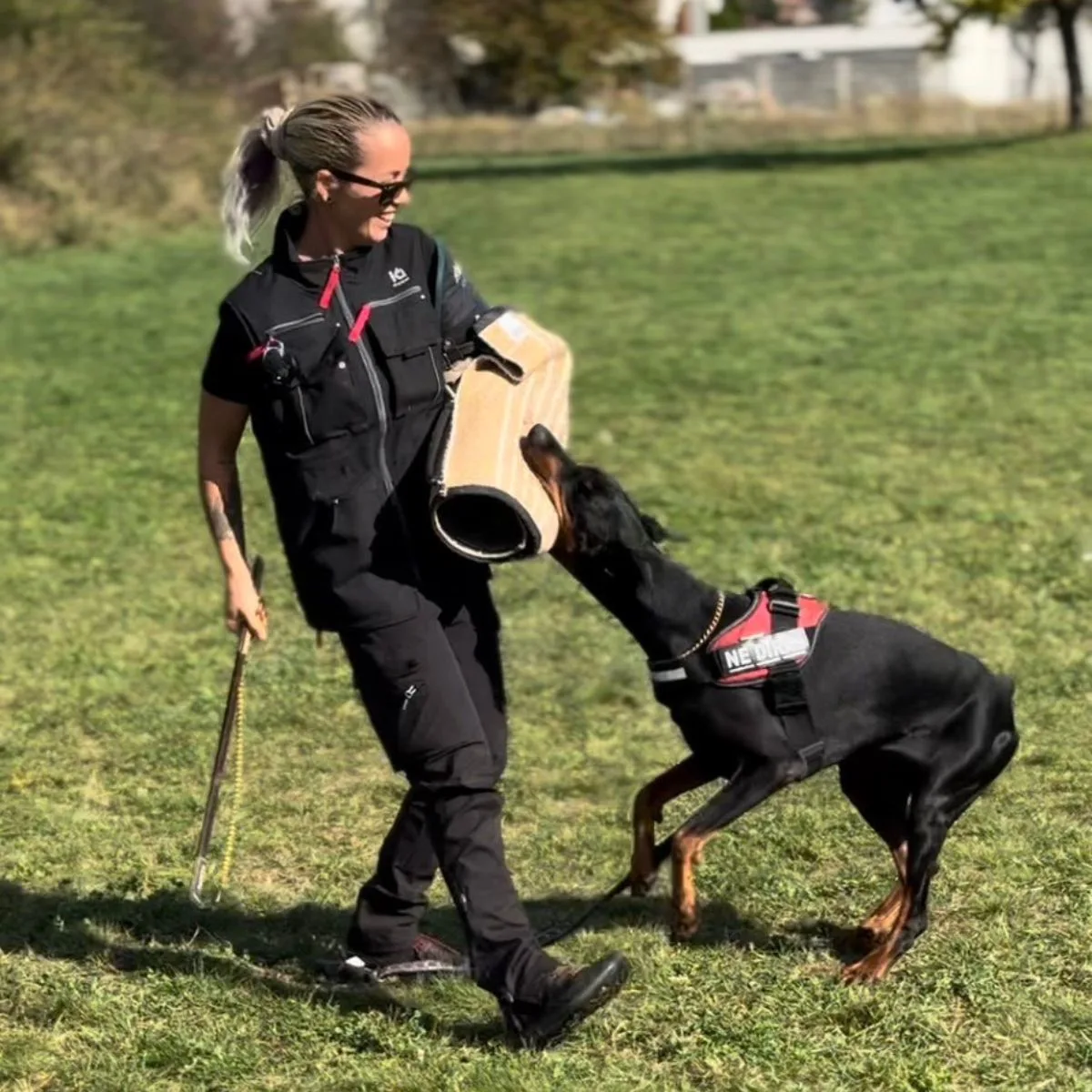
Nandina has been a lifelong dog owner and enthusiast. She shared her home with multiple breeds, including Giant Schnauzers, Cane Corsos, and Huskies. Currently, she is raising a three-year-old rescue and a working-line German Shepherd puppy.
Actively engaged in IGP dog sports for two years, Nandina is a certified instructor for basic obedience and socialization. She works as a trainer in her local dog sports club, and in her spare time, she handicrafts biothane gear for dogs.
